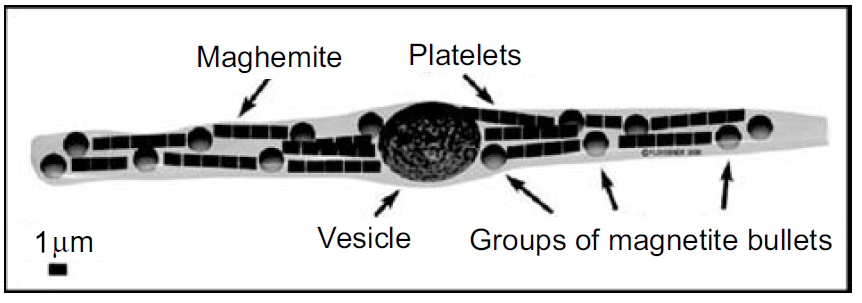


 الفيزياء الكلاسيكية
الفيزياء الكلاسيكية
 الكهربائية والمغناطيسية
الكهربائية والمغناطيسية
 علم البصريات
علم البصريات
 الفيزياء الحديثة
الفيزياء الحديثة
 النظرية النسبية
النظرية النسبية
 الفيزياء النووية
الفيزياء النووية
 فيزياء الحالة الصلبة
فيزياء الحالة الصلبة
 الليزر
الليزر
 علم الفلك
علم الفلك
 المجموعة الشمسية
المجموعة الشمسية
 الطاقة البديلة
الطاقة البديلة
 الفيزياء والعلوم الأخرى
الفيزياء والعلوم الأخرى
 مواضيع عامة في الفيزياء
مواضيع عامة في الفيزياء|
Read More
Date: 18-2-2021
Date: 3-3-2021
Date: 5-3-2021
|
Magnetotaxis
Life on Earth has evolved in the presence of a weak magnetic field of 10– 100Am−1. Inevitably, some creatures besides ourselves have learned to take advantage of this field. The clearest examples are magnetotactic bacteria, unicellular organismswhich manufacture particles of ferromagnetic iron oxides (magnetite or maghemitite) or sulphides (greigite). The particles grow in chains in the microbe’s body. Each one is of a size which would make it superparamagnetic if it stood alone, but the anisotropic dipole–dipole interaction in a chain of particles stabilizes the magnetization direction along the chain. Thus, every bacterium has a built-in compass needle, which is handed on to the next generation with the polarization direction intact, by cellular division. New particles added to the ends of the half-chain grow in the stray field there, and become magnetized parallel to their neighbours. In the language of rock magnetism, they acquire chemical remanent magnetization.
The value of magnetotaxis for bacteria is that it allows them to orient with the Earth’s magnetic field lines; they swim along them at about 100 μms−1, upwards or downwards according to the polarity of their built-in magnet. Polarity is of vital importance. Anaerobic bacteria swim downwards along the field lines, reaching mud where they flourish. Those with magnets of opposite

Figure 1: The magnetic sense organ in pigeons. It consists of three different structures, each containing magnetic material.
polarity swim upwards to the surface where they perish in the toxic oxygen-rich environment, a beautiful example of natural selection. Magnetotactic bacteria can be extracted from mud and made to dance in circles in a petri dish with a rotating magnetic field.
As many as 50 other creatures, including pigeons, salmon, bats, bees and deer are thought to have a magnetic sense. The magnetotaxis is more subtle, and it may operate in conjunction with other senses to find direction. In pigeons, for example, it was thought that the force between two magnetic particles attached to nerve endings is sensed, and the direction of the axis of the magnet pair relative to the field is distinguished by its attractive or repulsive force. There is no distinction between North/South or East/West but a maximum effect is perceived when the pigeon turns through 90◦. The pigeon’s magnetic sense organ has been identified (Fig. 1). It is obviously complex, but it is not yet known exactly how it works.
Other than force or torque exerted on ferrimagnetic particles, there are two other mechanisms that might be involved in magnetotaxis. One is induced emf in large moving conducting circuits, which may operate in sharks. The other is a possible effect on radical pair reactions, where a weak magnetic field may influence the singlet–triplet interconversion rate.
Epidemiologic studies of human exposure to low-frequency fields from power lines or domestic wiring have proved inconclusive. Large static magnetic fields seem to be innocuous, with exposure provoking little response at the level of the organism.1 Pigeons soon recover their magnetic sense, even after a spell in the bore of a 15 T magnet. Studies of the influence of high-frequency fields from mobile phones have provided no clear evidence of harm.



|
|
|
|
تفوقت في الاختبار على الجميع.. فاكهة "خارقة" في عالم التغذية
|
|
|
|
|
|
|
أمين عام أوبك: النفط الخام والغاز الطبيعي "هبة من الله"
|
|
|
|
|
|
|
قسم شؤون المعارف ينظم دورة عن آليات عمل الفهارس الفنية للموسوعات والكتب لملاكاته
|
|
|